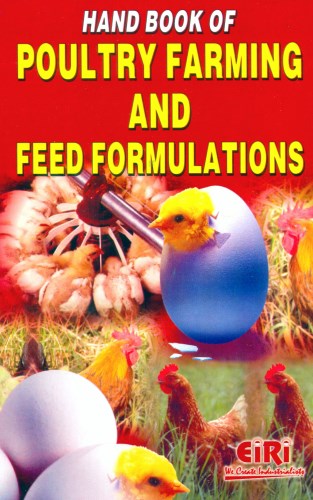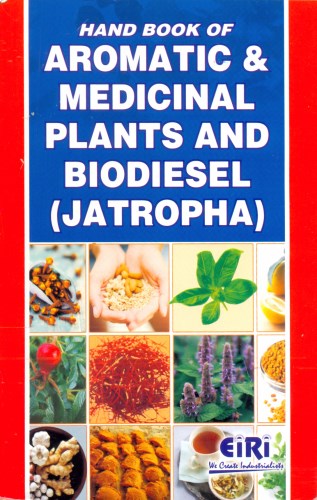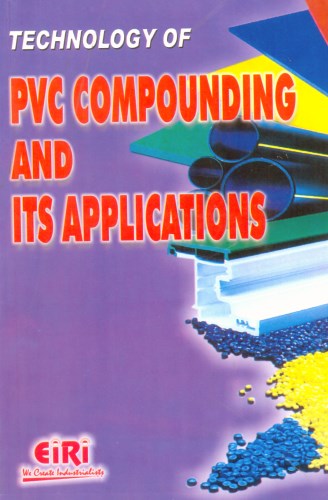Description
HAND BOOK OF POULTRY FARMING AND FEED FORMULATIONS
WHY POULTY FARMING ?
GENERAL ANATOMY OF POULTRY
Feathers of fowl
The Skin Skeletal System of Fowl
Muscular System
The respiratory system of fowl
The digestive system of fowl
Reproductive System
The Endocrine System
PRELIMINARY INFORMATIONS REGARDING POULTRY FARMING
Market
Availability and Selection of Day Old Chicks
Feed and Other Appliances
Drinking Water
Electric Supply
Selection of Site
House Management
Birds Management
Record Keeping
Technical Advise and Help
INVESTMENT PLANNING
Layer Farm
Broiler Farm
HOUSING REQUIREMENTS
Layer Housing
Broiler Farm
EQUIPMENTS NEEDED
Floor Brooders
Battery Brooder
Feeders
Waterers
Laying Nest
Miscellaneous Equipments
POULTRY BREEDING
Genetics in Brief
Inheritance of plumage in furkeys
Inheritance of quantitative characters
Systems of selection
Heritability
Selection Pressure
Selection Index
Breeding Methods
Pen mating
Flock Mating
Stud Mating
Shift system of mating
Artificial Insemination
Systems of Breeding in Poultry
A. System to increase homozygosity
Heterosis
Inheritance of Egg Production
Sexual Maturity
High intensity of lay (rate of lay)
Inheritance of Broodiness
Persistency
Winter pause
Facundity
Inheritance of characters related to Broiler Production
Growth rate
Feed Efficiency
Viability
Body conformation and skin colour
Feathering
Inheritance of Economic Traits in Turkeys
Breeding Plan for improvement of Turkeys
Inheritance of Economic traits in Ducks
Modern Method of Breeding
Recurrent Selection
Reciprocal Recurrent Selection
Poultry Breeding Research in India
Breeding Programme followed for layers
Commercial Broiler
POULTRY BROODING
Systems of Brooding
Hot room Brooding
Cold room Brooding
Location of Brooder House
Type of Brooders
Preparation of Brooder House to Receive Chicks
Brooder House Schedule upto 4 weeks of age
Brooding Requirements
Temperature
Ventilation
Humidity
Space
Equipments
Prevalent Management Programme
Chicks needed to start a farm
Jobs to be completed during brooding period
Vaccination
Debeaking
Coccidiosis control
Emergency during
Brooding Period
Preventing Starvation of turkey poults
Brooding of ducks
HOUSING AND EQUIPMENT
Location of a poultry Farm
Factors Influencing design of poultry houses
Temperature
Ventilation
Humidity
Requirement of floor space, feeders and waterers
Orientation of House
Light in poultry house
Poultry Houses
Hatchery
Brooder House
Advantages
Disadvantage
Processing Plant
Laying House
A small unit for 25 to 50 hens suitable for backyand (confined rearing) keeping
A Layer House for 1000 hens
Large size laying house
General Construction of laying house
Cage house
Common arrangement of cages
Breeding Pen
Equipment
Feeders
Waterers
Catching Equipments
Nests
Hatchery Equipment
FEED FORMULATIONS
Composition of Poultry Feeds
Nutrient Requirements of Birds
The Nutrient Composition of Feed Stuffs
Maximum level of Inclusion of feed Ingredients
Availability and cost of feed Ingredients
Methods of Formulating Rations
Square Method/Pearson Square Method
Trail & Error Method
Simultaneous Equation Method
The 2×2 Matrix Method
Computer Method
Linear Programming Package (LP88)
Procedure for use of Linear Programming (LP)
Selection of Computer Software and Hardware for Ration formulation
Steps in Feed Formulation
Diets for Various Classes of Chicken
Meat Type Chicken
Egg Type Chicken
Least Cost Formulation
Broller starter diets
Chick starter diets
Grower diets
Layer diets
Computerized Diets
DISEASE PREVENTION
Vaccination of Layer Chicks and Adults
Preventive Medication for Layers
Coccidiostat
Dewormer
Manage and Mites
Vaccination for Broliers
Preventive Medication for Broilers
ECONOMIC RAISING OF POULTRY (Broiler, Layer, Ducks, Quail and Turkey)
Broiler Farming
Layers Farming
Duck Farming
Choice of Breeds
Tips for General Care and Management
A tentative plan for setting up a duck farm for eggs of Khaki Campbell variety Capacity
1,000 birds
Nutrition and Feeding
Quail Farming
Tips of Management of Quail Rearing for Meat Purpose
Economic Aspects of Quail Rearing
Turkey Raising
Housing
Egg Production
Incubation
Brooding
Feeding
Diseases
Economics
Facilities for Farmers at CCS, HAU, Hisar
LIST OF MEDICINE, VACCINE AND NUTRIENT MANUFACTURERS
LIST OF POULTRY FEED MANUFACTURERS, DISTRIBUTOR AND SUPPLIERS
LIST OF IMPORTANT HATCHERIES
LIST OF EQUIPMENT MANUFACTURERS AND SUPPLIERS
LIST OF SOME IMPORTANT FORMULATION OF POULTRY FARMERS USE ANTIBACTERIAL DRUGS
Antiobiotics
Sulpha Drugs
Nitro Furans
LIST OF ANTICOCCIDIALS
ANTICOCCIDIALS PREVENTIVE
LIST OF ANTIPARASITIC FORMULATIONS
LIST OF COMMON VACCINES USED FOR POULTRY AVAILABLE IN MARKET
SUPPLIERS OF PLANT & EQUIPMENTS FOR POULTRY
PLANT ECONOMICS OF ANIMAL FEED
PLANT ECONOMICS OF BIO FERTILISERS FROM WASTE
PLANT ECONOMICS OF CHICKEN FARMING (HATCHERY)
PLANT ECONOMICS OF POULTRY & BROILER (HATCHERY) FARMING
PLANT ECONOMICS OF POULTRY FARMING
PLANT ECONOMICS OF POULTRY FEEDS
PLANT ECONOMICS OF POULTRY & BROILER FARMING
Engineers India Research Institute (EIRI) is a renowned name in the industrial world for offering technical
and financial consultancy services.
EIRI services are:
Detailed Feasibility Reports
New Project Identification
Project Feasibility and Market Study
Identification of Lucrative Industrial Project Opportunities
Preparation of Project Profiles / Pre-Investment and Detailed Feasibility Studies,
Market Surveys / Studies, Market Survey Cum Detailed Techno-Economic Feasibility Reports
Project Reports in CD Roms
Identification of Plant /Process/Machinery and Equipment, Industrial General Guidance for setting up new
industrial projects.
Our most up-to-date and Technologically Advanced Industrial Project Reports, categorized with respect to
Financial Outlays and Sector – wise Classification are immensely useful for :
Existing Small or Medium Scale Industrialists facing competition from large houses
Young Entrepreneurs dreaming to start their own industrial enterprise
Young Graduates and Professionals wishing to begin their career
Industrialists interested in Debottlenecking their capacities & New Product – Lines
Large Industrial Houses pursuing Expansion, Growth and Diversification Plans
Sample Chapter
Before starting any enterprise, one must have to obtain some knowledge and gather preliminary informations for smooth take up. Central and State Government Agencies and Agricultural Universities of the states are imparting training of short durations which are very helpful for the beginners. Beside these agencies, private breeder, feed manufacturers and other
organisations dealing with poultry are also trying to disseminate informations through workshop, seminars, etc. Apart from these training, seminars and symposiums, one has to gather some basic informations for his own use as a
sound base. These can be discussed as follows:
(I) MARKET
What are the avenues to reach the consumers? A direct contact may not be feasible. If possible, it is itself a business and a busy farmer may not like to involve himself. The co-operatives which are coming up for the marketing of eggs and boilers are welcome development for the farmers.
The present contact system, although working somehow, may not be a favourable proposition for long duration. One has to note down what system is prevalent and what are under development. He has also to analyse the price fluctuations and their pertinent reasons to regulate his production and product distribution.
The market and the farm should be well communicated. They should not be only near and joined by metalled roads but telecommunication facilities, if available, can be utilized with benefits. Long distance dispatch of live broilers reduce their weight at the time of disposal and in case of eggs, damage percentage is increased substantially.
(II) AVAILABILITY AND SELECTION OF DAY OLD CHICKS
Whether one has to start a layer farm or broiler farm, he has to purchase day old chicks of high genetic potential. Both the body weight of broilers at 15 marketable age and egg production of laying birds, are genetic character of the chicks which cannot be substituted by any level of management and quality feeding. What are the hatcheries and what is their reputation in the area, where the farm is to be located? What are their terms of supply and how regular they are in their supply of chicks and services? Whether the parent stocks are Salmonella free and what vaccines they are using at the
time of supply of chicks? These are some of the informations one has to seek before and at the time of selecting chicks to begin with. These informations can be gathered from breeders and reliable farmers. Govt. of India conduct Random Sample Test for layers and broilers chicks in four agroclimatic zones (centres) to evaluate and compare the production
potential. Participation from private breeders and government agencies, is optional and not mandatory. The results of such test are published every year. Consultation of these results can substantiate the informations gathered through private breeders. Some addresses of private as well as Government hatcheries/breeders have been appended in the last chapter.
(III) FEED AND OTHER APPLIANCES
After deciding about the chicks, the next item to be considered is the availability of balanced feed. The feed cost is about 60 to 70 per cent of the total expenditure on poultry raising. Hence, any saving in feed cost or improvement in the conversion of feed to the product is bound to enhance the profit margin substantially. One can think and try to manufacture his own feed for his flock. But, feed compounding and manufacturing is itself an enterprise and broiler raisers or layers farmers should avoid to venture for it, if it is not absolutely essential. There is no alternative to fresh and well balanced compounded feed. If possible, its supply should be regular and direct from the factory to avoid mischieves from the contractors and to get fresh feed free from rancidity and fungi.
Several poultry appliances are required such as feeders, waters, brooders batteries, crates, etc. These can be locally manufactured or are available with certain manufacturers in the nearby cities. One should not go for the initial cost if the goods are of quality and are durable. The addresses of the feed manufacturers and agro industries supplying poultry appliances have also been appended.
(IV) DRINKING WATER
Although, the water supply involves little cost, but its importance cannot be ignored. Poultry require round-the-clock supply of water. The water quality affects the condition of birds and their production. The portable water used
for human consumption is of the best quality if the supply is regular and plentiful. The problem arises only when ground water has to be used. Such water must be tested in the water testing laboratory. The content of soluble salts, suspended microbes and other toxic constituents should be within the tolerance limit. The total soluble solids should be below 3,000 mg per liter of water.
(V) ELECTRIC SUPPLY
Electricity plays very crucial role in poultry farming. Chicks have to be raised under elevated temperatures (95 to 80°F) in the initial period of their life. Broiler require light for almost whole night for proper feeding and hence, their growth. The layers require a definite photo-period for initiation and maintenance of their production. In summer, one may require regular electric supply. While deciding the location of the farm, the electric supply has to be considered first.
(VI) SELECTION OF SITE
Any farmer has an option to go for better breed of chicks or brand






